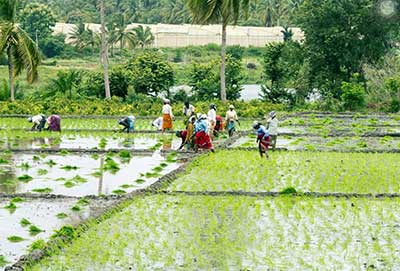Relevance: GS-3: Agricultural produce and issues and related constraints
Key phrases: Situation Assessment Survey 2019, National Livestock Mission, Pradhan Mantri Matsya Sampada Yojana, production-linked incentive scheme, Agriculture Infrastructure Fund, Farmer Producer Organisations (FPOs)
Context
- Agriculture has registered a robust performance during the COVID-19 pandemic and has clocked decent growth rates of 4.3% and 3.6% during 2019-20 and 2020-21.
- In 2021-22, growth is projected to be around 3.9%, which is a very satisfactory performance. This performance may partly explain the lack of any extra focus on agriculture.
- Within agriculture, livestock and fisheries are two subsectors that have
shown an average annual growth rate of 8% or more in the last five years.
- These two subsectors roughly contribute about 33% of the gross value added in agriculture.
- As per the Situation Assessment Survey 2019, more than 15% of income is derived from livestock subsectors.
What are the Agri-subsectors which are given more allocation in the Budget?
- The allocation for livestock health and disease control — a major concern for those working in the sector — has increased from ₹886 crore to ₹2,000 crore, a 126% increase.
- The allocation for the National Livestock Mission has also increased by more than ₹100 crore (42%).
- The Pradhan Mantri Matsya Sampada Yojana, a flagship programme of fisheries, has received an increase of about ₹679 crore (57%).
- Value addition in agriculture has also got increased allocation:
- The production-linked incentive scheme for food processing has received a huge increase, from ₹10 crore to ₹1,022 crore (a 10,000% jump).
- The allocation for micro food processing, which can help in really small enterprises such as pickle and jaggery making, has increased by 125% to ₹900 crore.
- Capital Investment also has good budgetary allocation:
- The allocation for the Rashtriya Krishi Vikas Yojana, or RKVY (a programme to “ensure holistic development of agriculture and allied sectors”) has been increased by a whopping ₹8,000 crore, a 400% increase.
- Pradhan Mantri Krishi Sinchayee Yojana (PMKSY) — to improve farm productivity — the Paramparagat Krishi Vikas Yojana (a programme to “increase soil fertility and also the production of healthy food through organic practices” among other things), etc. have been brought under the RKVY fold this year. The budgetary allocation was too impressive this year.
- Agri-infrastructure: The allocation for the Agriculture Infrastructure Fund (AIF) has been increased by 150% to ₹500 crore.
- The central sector scheme called the Formation and Promotion of 10,000 Farmer Producer Organisations (FPOs) has also received an allocation of ₹500 crore (100% increase).
- Most major rural development programmes such as the Pradhan Mantri Gram Sadak Yojana (connectivity to unconnected habitations), the Pradhan Mantri Awas Yojana (housing for all in urban areas), and the National Rural Livelihood Mission have received small increases in allocations.
What are the Agri-subsectors which are given less allocation in the Budget?
- Output price support seen major decrement:
- For instance, the Pradhan Mantri Annadata Aay SanraksHan Abhiyan (PM-AASHA), which is the flagship programme to provide enhanced Minimum Support Price (MSP) of 50% above the cost of production to farmers (started with a lot of expectation in 2018), has received an allocation of just ₹1 crore!
- The allocation for the price support programme of pulses and oilseeds (the Market Intervention Scheme and Price Support Scheme, or MIS-PSS) has decreased by 58% to ₹1,500 crore.
- The allocation for price stabilisation fund, meant to address extreme volatility in the prices of perishables, has declined by ₹750 crore (33%).
- The decline in budgeted allocation for vital subsidies:
- The budgeted estimate of fertilizer subsidy has shown a decline of nearly ₹35,000 crore (25%).
- Similarly, the food subsidy has shown a decline of nearly ₹79,000 crore (28%). Such a large decline in fertilizer and food subsidies does not appear achievable.
- MGNREGA minimised:
- In the rural economy, with nearly 40% of income being derived from wages by agricultural households, it is imperative that rural development is looked at in conjunction with agriculture.
- Mahatma Gandhi National Rural Employment Guarantee Scheme (MGNREGS). This flagship rural employment programme, which has been instrumental in reducing distress in the rural economy during the waves of the COVID-19 pandemic, has received lower allocation — by about ₹25,000 crore (25% decrease) from RE 2021-22 of ₹98,000 crore.
- This is a large decline indeed. A plausible reason is the possible reduction in the need for MGNREGS with the decline in the severity of the pandemic.
Way Forward
- Budgetary Visionary and Transformative steps:
- The measures to promote kisan drones and encourage start-ups to improve value chains of farm produce are very relevant steps.
- The adoption of modern technology in agriculture should not only help reinvigorate the rural economy but could also possibly encourage the younger generation to consider agriculture as a career option — generally perceived to be a laborious and drudgery-laden sector.
- The nitro-thrust seems to be on important subsectors such as livestock, fisheries and food processing and also on improving infrastructure in the crop sector are very welcome steps.
- Although the allocations on MGNREGA and food and fertilizer subsidies are somewhat lower, there are positives in terms of adoption of technology. The Budget is in the right direction for agriculture. And now, implementation holds the key
Source: The Hindu
Mains Question:
Q. Stagnant farmer incomes, weak supply chains and huge post harvest loss present a strong case to develop agriculture in India as an enterprise. Discuss how the budgetary allocation for fiscal year 2022-23 can help in development of farming as an enterprise and increasing the farm incomes. (15 marks).









